Abstract
1. Rectus abdominis muscle biopsies were obtained from 28 patients undergoing abdominal surgery. In membranes prepared from these biopsies beta-adrenoceptor binding was examined. The apparent affinity (KD) and the density (Bmax) of the receptors for the radioligand (-)-[125I]cyanopindolol were 28.5 +/- 2.7 (pM) and 25.9 +/- 2.1 (fmol mg-1 protein) (mean +/- s.e. mean) respectively. In forceps biopsies from vastus lateralis muscle from four healthy volunteers the values for KD and Bmax were 22.5 +/- 4.4 (pM) and 16.4 +/- 2.2 (fmol mg-1 protein). The binding characteristics for the radioligand were similar in the biopsies from the two muscle sites. 2. Inhibition of the radioligand binding by the selective beta 2-adrenoceptor antagonist ICI 118551 (KI = 117 +/- 45 nM) and selective beta 1-adrenoceptor antagonist metoprolol (KI = 15229 +/- 5046 nM) suggests the dominance of beta 2-adrenoceptor subtype in human skeletal muscle. 3. There were no significant differences in the skeletal muscle beta-adrenoceptor densities or affinities between the young and older patients.
Full text
PDF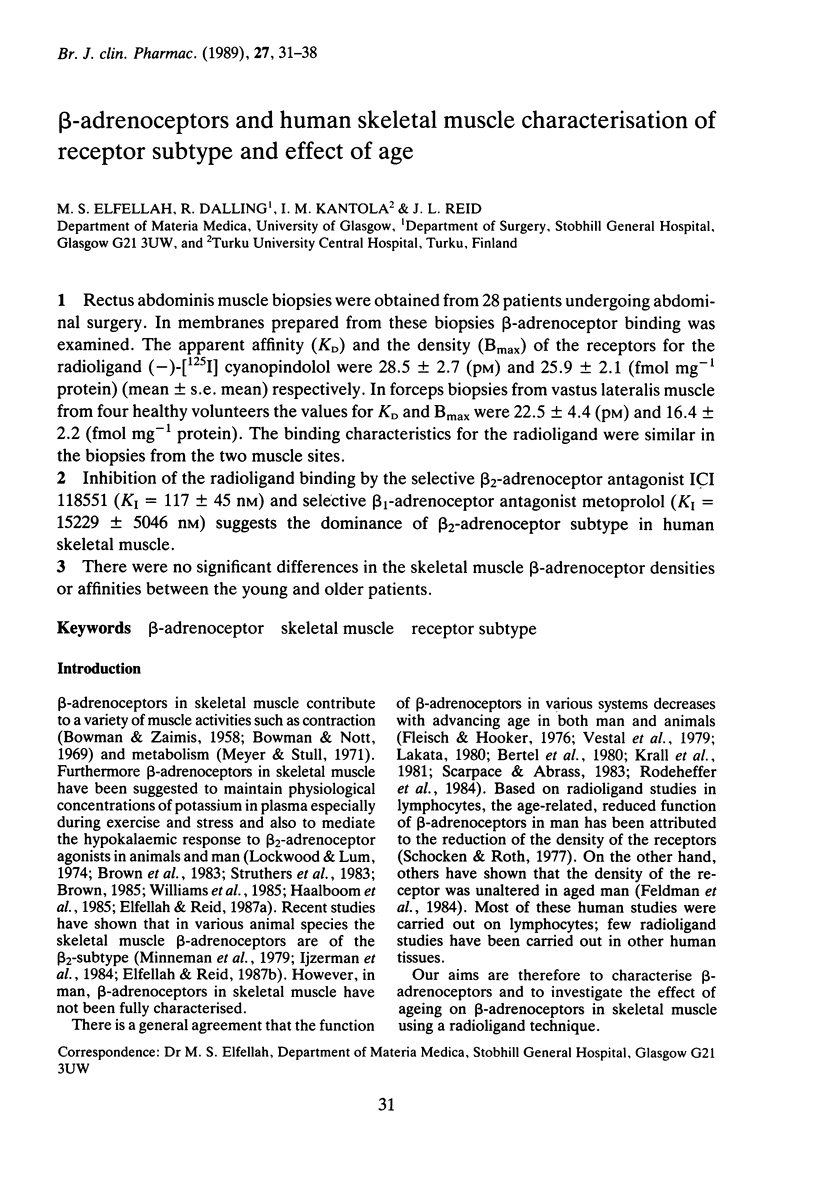
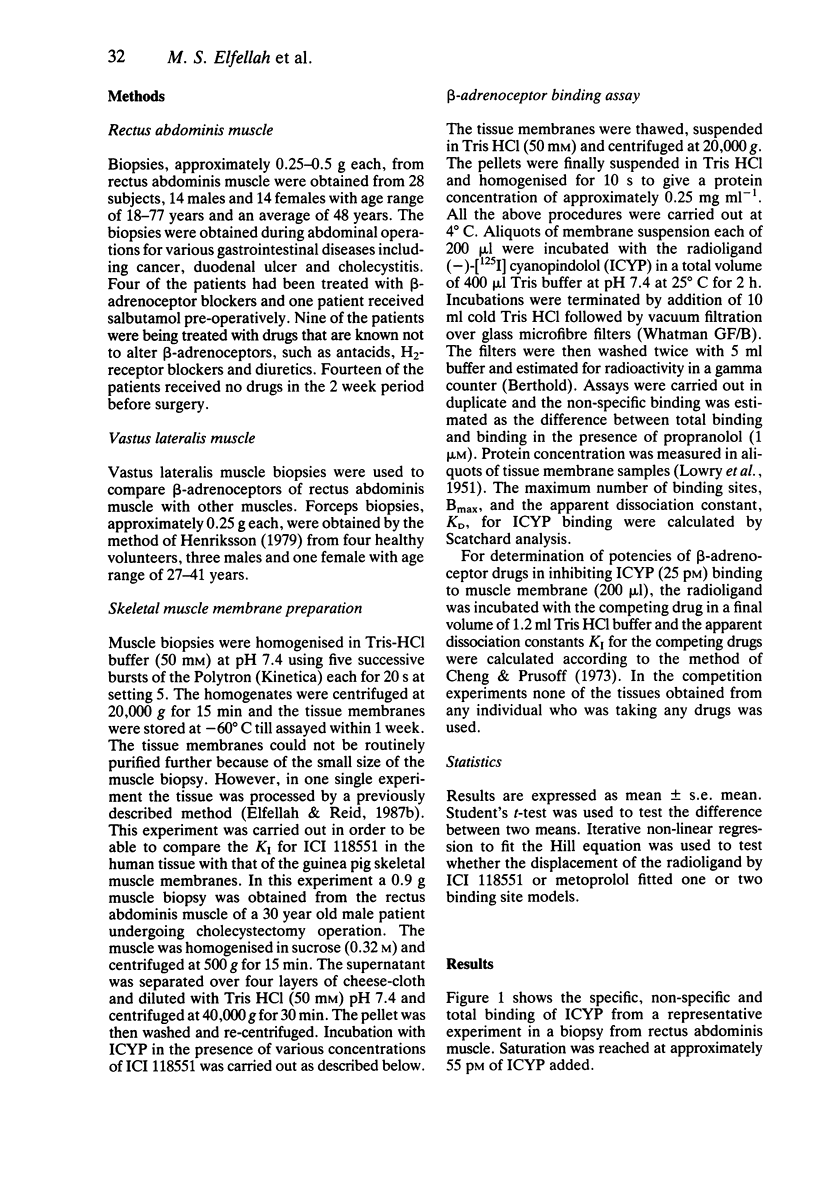
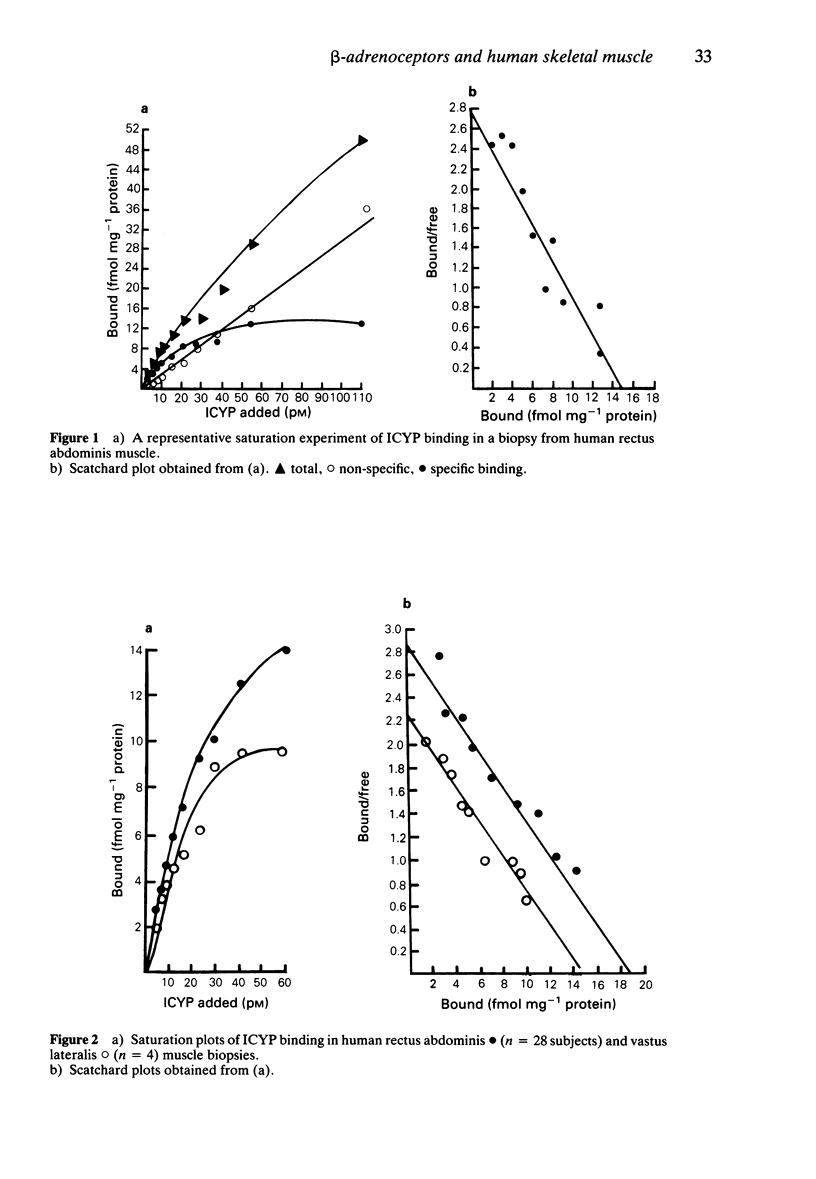
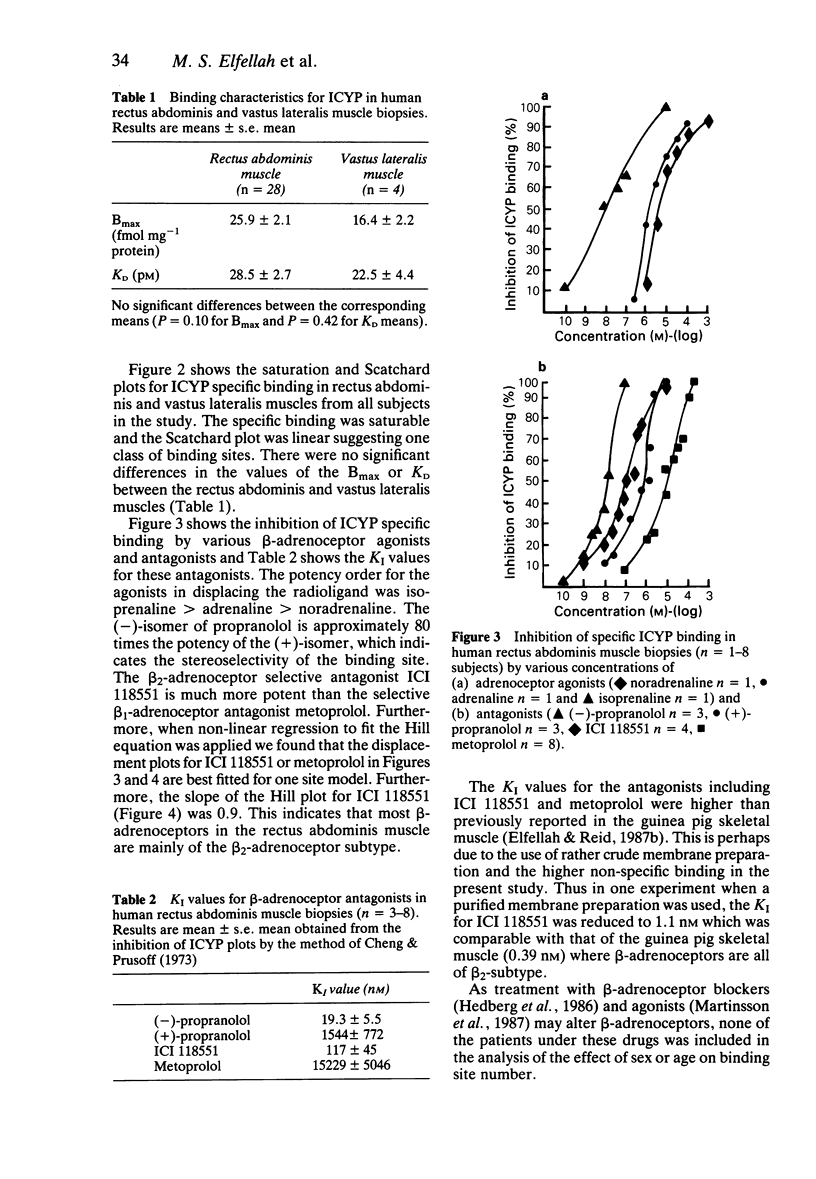
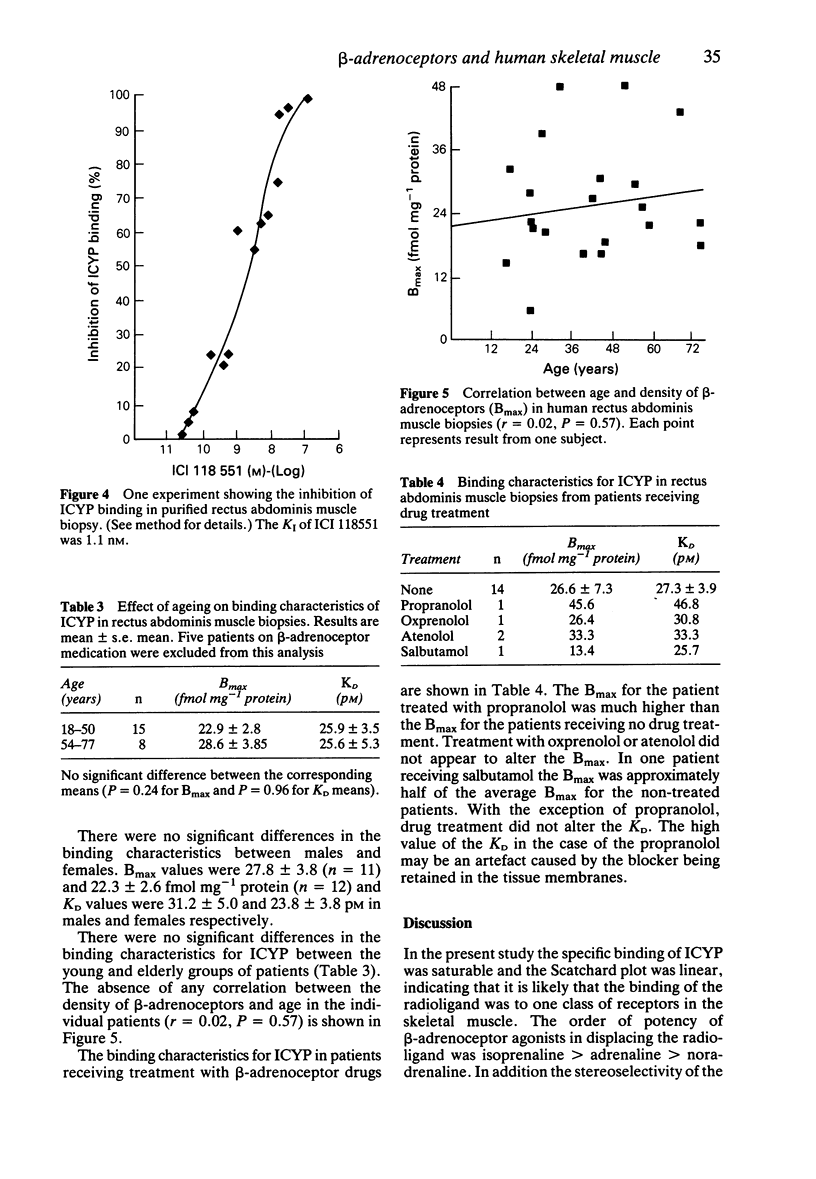
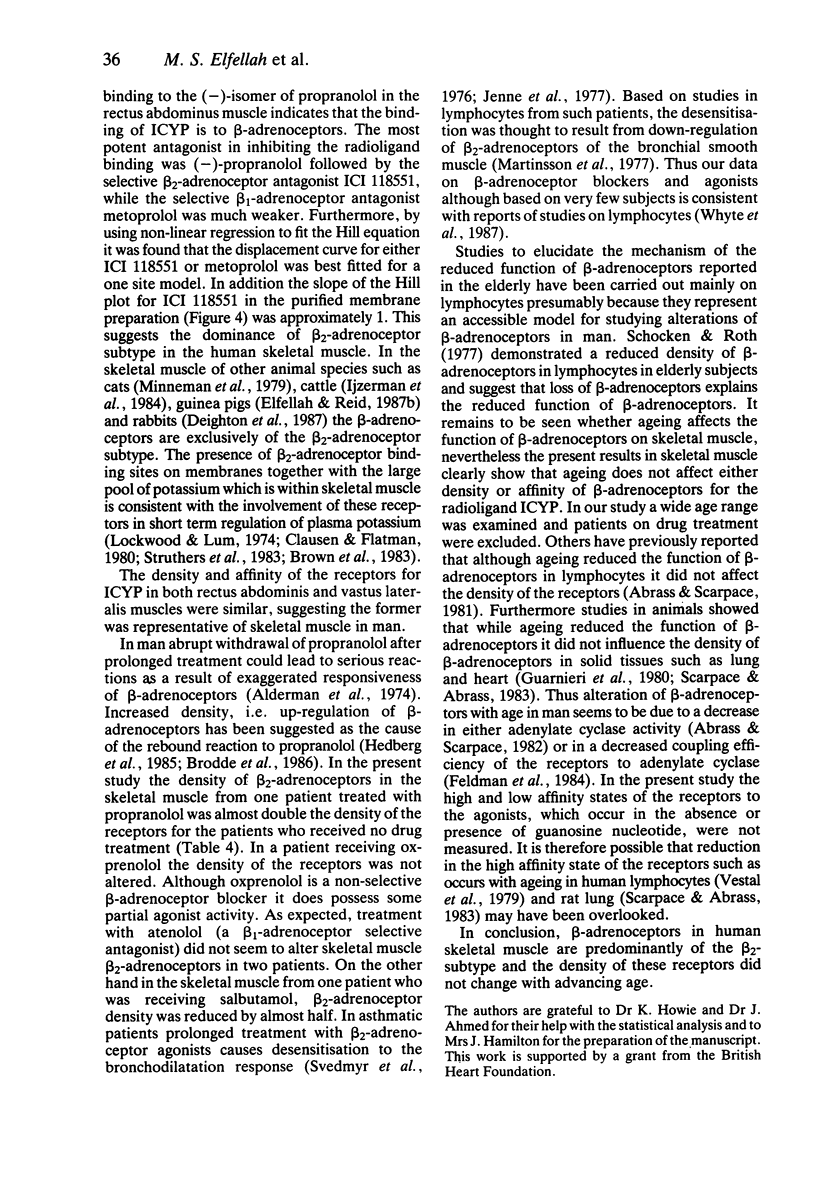
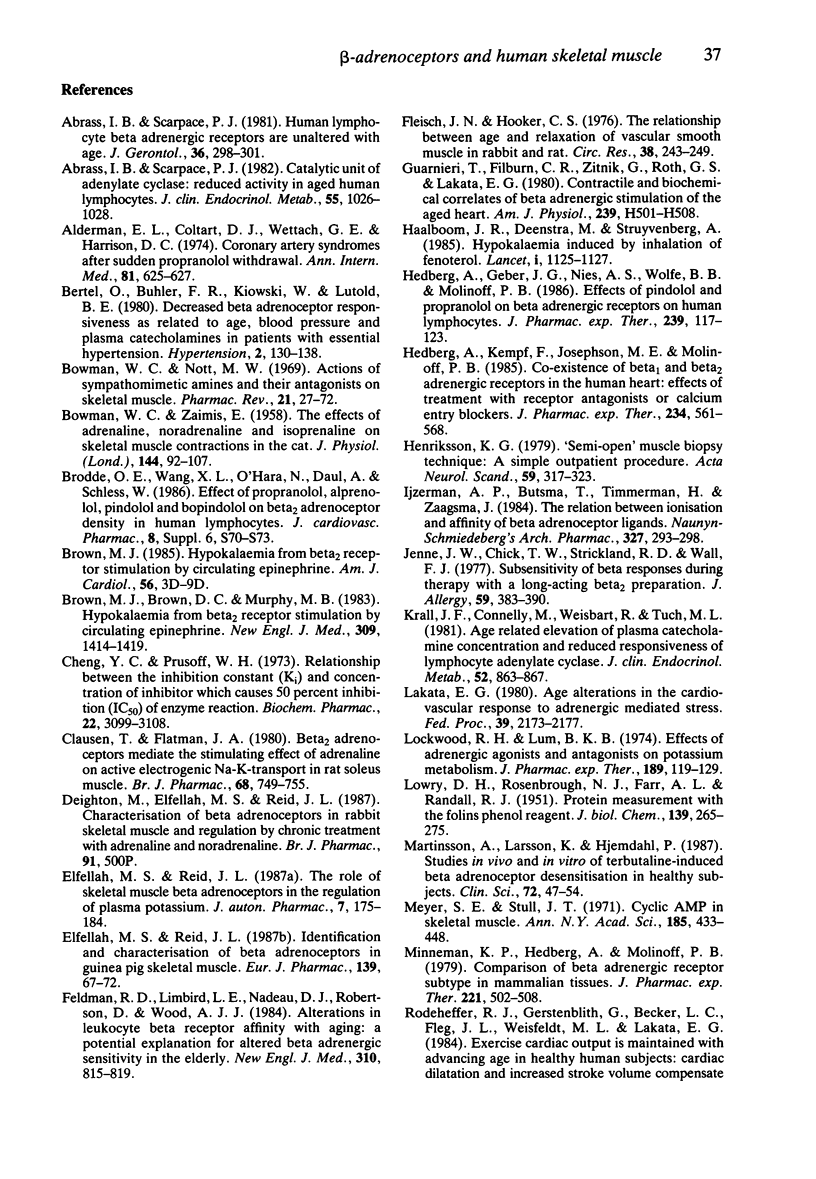
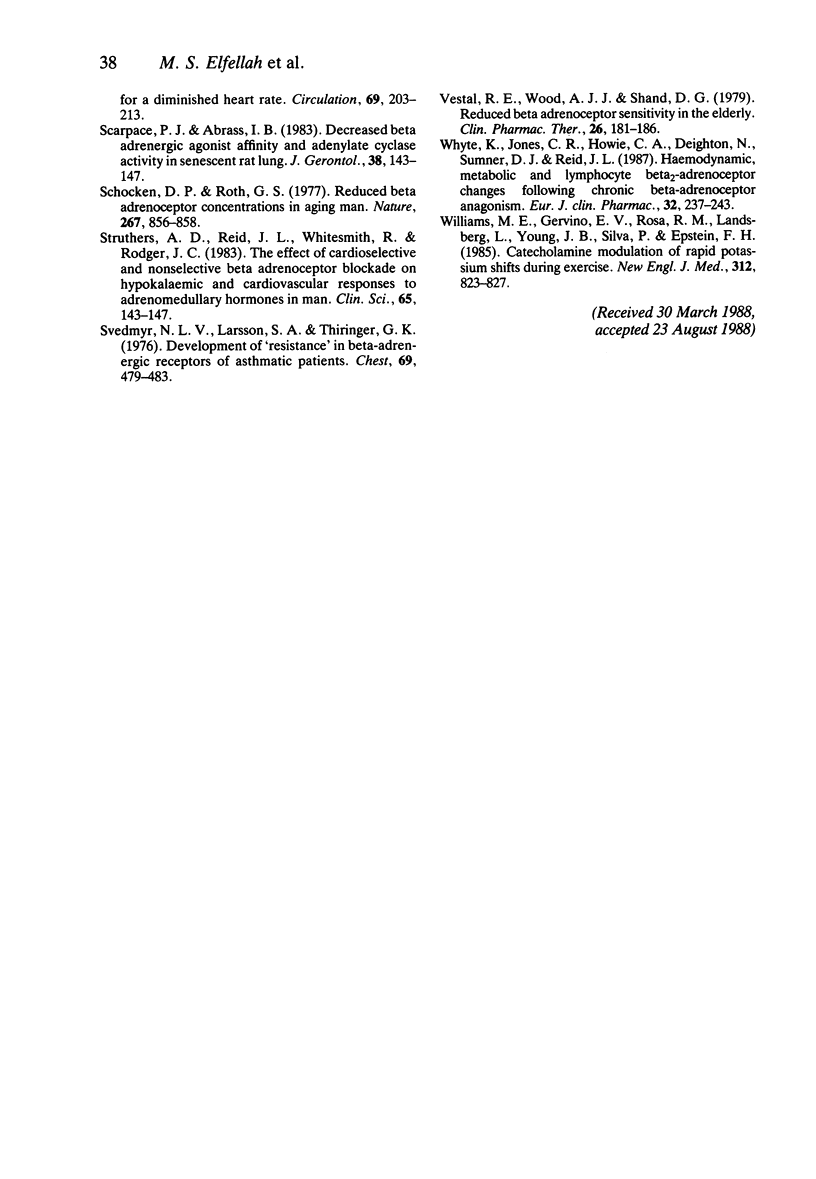
Selected References
These references are in PubMed. This may not be the complete list of references from this article.
- Abrass I. B., Scarpace P. J. Catalytic unit of adenylate cyclase: reduced activity in aged-human lymphocytes. J Clin Endocrinol Metab. 1982 Nov;55(5):1026–1028. doi: 10.1210/jcem-55-5-1026. [DOI] [PubMed] [Google Scholar]
- Abrass I. B., Scarpace P. J. Human lymphocyte beta-adrenergic receptors are unaltered with age. J Gerontol. 1981 May;36(3):298–301. doi: 10.1093/geronj/36.3.298. [DOI] [PubMed] [Google Scholar]
- Alderman E. L., Coltart D. J., Wettach G. E., Harrison D. C. Coronary artery syndromes after sudden propranolol withdrawal. Ann Intern Med. 1974 Nov;81(5):625–627. doi: 10.7326/0003-4819-81-5-625. [DOI] [PubMed] [Google Scholar]
- BOWMAN W. C., ZAIMIS E. The effects of adrenaline, noradrenaline and isoprenaline on skeletal muscle contractions in the cat. J Physiol. 1958 Nov 10;144(1):92–107. doi: 10.1113/jphysiol.1958.sp006088. [DOI] [PMC free article] [PubMed] [Google Scholar]
- Bertel O., Bühler F. R., Kiowski W., Lütold B. E. Decreased Beta-adrenoreceptor responsiveness as related to age, blood pressure, and plasma catecholamines in patients with essential hypertension. Hypertension. 1980 Mar-Apr;2(2):130–138. doi: 10.1161/01.hyp.2.2.130. [DOI] [PubMed] [Google Scholar]
- Bowman W. C., Nott M. W. Actions of sympathomimetic amines and their antagonists on skeletal muscle. Pharmacol Rev. 1969 Mar;21(1):27–72. [PubMed] [Google Scholar]
- Brodde O. E., Wang X. L., O'Hara N., Daul A., Schiess W. Effect of propranolol, alprenolol, pindolol, and bopindolol on beta 2-adrenoceptor density in human lymphocytes. J Cardiovasc Pharmacol. 1986;8 (Suppl 6):S70–S73. doi: 10.1097/00005344-198608006-00016. [DOI] [PubMed] [Google Scholar]
- Brown M. J., Brown D. C., Murphy M. B. Hypokalemia from beta2-receptor stimulation by circulating epinephrine. N Engl J Med. 1983 Dec 8;309(23):1414–1419. doi: 10.1056/NEJM198312083092303. [DOI] [PubMed] [Google Scholar]
- Cheng Y., Prusoff W. H. Relationship between the inhibition constant (K1) and the concentration of inhibitor which causes 50 per cent inhibition (I50) of an enzymatic reaction. Biochem Pharmacol. 1973 Dec 1;22(23):3099–3108. doi: 10.1016/0006-2952(73)90196-2. [DOI] [PubMed] [Google Scholar]
- Clausen T., Flatman J. A. Beta 2-adrenoceptors mediate the stimulating effect of adrenaline on active electrogenic Na-K-transport in rat soleus muscle. Br J Pharmacol. 1980 Apr;68(4):749–755. doi: 10.1111/j.1476-5381.1980.tb10868.x. [DOI] [PMC free article] [PubMed] [Google Scholar]
- Elfellah M. S., Reid J. L. Identification and characterisation of beta-adrenoceptors in guinea-pig skeletal muscle. Eur J Pharmacol. 1987 Jul 2;139(1):67–72. doi: 10.1016/0014-2999(87)90498-5. [DOI] [PubMed] [Google Scholar]
- Elfellah M. S., Reid J. L. The role of skeletal muscle beta-adrenoreceptors in the regulation of plasma potassium. J Auton Pharmacol. 1987 Jun;7(2):175–184. doi: 10.1111/j.1474-8673.1987.tb00147.x. [DOI] [PubMed] [Google Scholar]
- Feldman R. D., Limbird L. E., Nadeau J., Robertson D., Wood A. J. Alterations in leukocyte beta-receptor affinity with aging. A potential explanation for altered beta-adrenergic sensitivity in the elderly. N Engl J Med. 1984 Mar 29;310(13):815–819. doi: 10.1056/NEJM198403293101303. [DOI] [PubMed] [Google Scholar]
- Fleisch J. H., Hooker C. S. The relationship between age and relaxation of vascular smooth muscle in the rabbit and rat. Circ Res. 1976 Apr;38(4):243–249. doi: 10.1161/01.res.38.4.243. [DOI] [PubMed] [Google Scholar]
- Guarnieri T., Filburn C. R., Zitnik G., Roth G. S., Lakatta E. G. Contractile and biochemical correlates of beta-adrenergic stimulation of the aged heart. Am J Physiol. 1980 Oct;239(4):H501–H508. doi: 10.1152/ajpheart.1980.239.4.H501. [DOI] [PubMed] [Google Scholar]
- Haalboom J. R., Deenstra M., Struyvenberg A. Hypokalaemia induced by inhalation of fenoterol. Lancet. 1985 May 18;1(8438):1125–1127. doi: 10.1016/s0140-6736(85)92432-8. [DOI] [PubMed] [Google Scholar]
- Hedberg A., Gerber J. G., Nies A. S., Wolfe B. B., Molinoff P. B. Effects of pindolol and propranolol on beta adrenergic receptors on human lymphocytes. J Pharmacol Exp Ther. 1986 Oct;239(1):117–123. [PubMed] [Google Scholar]
- Hedberg A., Kempf F., Jr, Josephson M. E., Molinoff P. B. Coexistence of beta-1 and beta-2 adrenergic receptors in the human heart: effects of treatment with receptor antagonists or calcium entry blockers. J Pharmacol Exp Ther. 1985 Sep;234(3):561–568. [PubMed] [Google Scholar]
- Henriksson K. G. "Semi-open" muscle biopsy technique. A simple outpatient procedure. Acta Neurol Scand. 1979 Jun;59(6):317–323. [PubMed] [Google Scholar]
- IJzerman A. P., Bultsma T., Timmerman H., Zaagsma J. The relation between ionization and affinity of beta-adrenoceptor ligands. Naunyn Schmiedebergs Arch Pharmacol. 1984 Oct;327(4):293–298. doi: 10.1007/BF00506239. [DOI] [PubMed] [Google Scholar]
- Jenne J. W., Chick T. W., Strickland R. D., Wall F. J. Subsensitivity of beta responses during therapy with a long-acting beta-2 preparation. J Allergy Clin Immunol. 1977 May;59(5):383–390. doi: 10.1016/0091-6749(77)90023-9. [DOI] [PubMed] [Google Scholar]
- Krall J. F., Connelly M., Weisbart R., Tuck M. L. Age-related elevation of plasma catecholamine concentration and reduced responsiveness of lymphocyte adenylate cyclase. J Clin Endocrinol Metab. 1981 May;52(5):863–867. doi: 10.1210/jcem-52-5-863. [DOI] [PubMed] [Google Scholar]
- LOWRY O. H., ROSEBROUGH N. J., FARR A. L., RANDALL R. J. Protein measurement with the Folin phenol reagent. J Biol Chem. 1951 Nov;193(1):265–275. [PubMed] [Google Scholar]
- Lockwood R. H., Lum B. K. Effects of adrenergic agonists and antagonists on potassium metabolism. J Pharmacol Exp Ther. 1974 Apr;189(1):119–129. [PubMed] [Google Scholar]
- Martinsson A., Larsson K., Hjemdahl P. Studies in vivo and in vitro of terbutaline-induced beta-adrenoceptor desensitization in healthy subjects. Clin Sci (Lond) 1987 Jan;72(1):47–54. doi: 10.1042/cs0720047. [DOI] [PubMed] [Google Scholar]
- Mayer S. E., Stull J. T. Cyclic AMP in skeletal muscle. Ann N Y Acad Sci. 1971 Dec 30;185:433–448. doi: 10.1111/j.1749-6632.1971.tb45271.x. [DOI] [PubMed] [Google Scholar]
- Minneman K. P., Hedberg A., Molinoff P. B. Comparison of beta adrenergic receptor subtypes in mammalian tissues. J Pharmacol Exp Ther. 1979 Dec;211(3):502–508. [PubMed] [Google Scholar]
- Rodeheffer R. J., Gerstenblith G., Becker L. C., Fleg J. L., Weisfeldt M. L., Lakatta E. G. Exercise cardiac output is maintained with advancing age in healthy human subjects: cardiac dilatation and increased stroke volume compensate for a diminished heart rate. Circulation. 1984 Feb;69(2):203–213. doi: 10.1161/01.cir.69.2.203. [DOI] [PubMed] [Google Scholar]
- Scarpace P. J., Abrass I. B. Decreased beta-adrenergic agonist affinity and adenylate cyclase activity in senescent rat lung. J Gerontol. 1983 Mar;38(2):143–147. doi: 10.1093/geronj/38.2.143. [DOI] [PubMed] [Google Scholar]
- Schocken D. D., Roth G. S. Reduced beta-adrenergic receptor concentrations in ageing man. Nature. 1977 Jun 30;267(5614):856–858. doi: 10.1038/267856a0. [DOI] [PubMed] [Google Scholar]
- Struthers A. D., Reid J. L., Whitesmith R., Rodger J. C. The effects of cardioselective and non-selective beta-adrenoceptor blockade on the hypokalaemic and cardiovascular responses to adrenomedullary hormones in man. Clin Sci (Lond) 1983 Aug;65(2):143–147. doi: 10.1042/cs0650143. [DOI] [PubMed] [Google Scholar]
- Svedmyr N. L., Larsson S. A., Thiringer G. K. Development of "resistance" in beta-adrenergic receptors of asthmatic patients. Chest. 1976 Apr;69(4):479–483. doi: 10.1378/chest.69.4.479. [DOI] [PubMed] [Google Scholar]
- Vestal R. E., Wood A. J., Shand D. G. Reduced beta-adrenoceptor sensitivity in the elderly. Clin Pharmacol Ther. 1979 Aug;26(2):181–186. doi: 10.1002/cpt1979262181. [DOI] [PubMed] [Google Scholar]
- Whyte K., Jones C. R., Howie C. A., Deighton N., Sumner D. J., Reid J. L. Haemodynamic, metabolic, and lymphocyte beta 2-adrenoceptor changes following chronic beta-adrenoceptor antagonism. Eur J Clin Pharmacol. 1987;32(3):237–243. doi: 10.1007/BF00607569. [DOI] [PubMed] [Google Scholar]
- Williams M. E., Gervino E. V., Rosa R. M., Landsberg L., Young J. B., Silva P., Epstein F. H. Catecholamine modulation of rapid potassium shifts during exercise. N Engl J Med. 1985 Mar 28;312(13):823–827. doi: 10.1056/NEJM198503283121304. [DOI] [PubMed] [Google Scholar]


